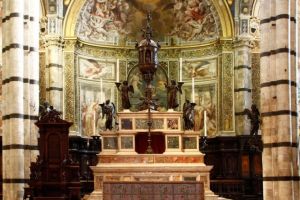The Cathedral of Santa Maria Assunta
Eigh Altar
The altar is the center of the house of worship, the visible sign of Christ, the cornerstone on which God builds the Christian community. The original altar of the cathedral, on which the great Maestà by Duccio stood from 1311, was replaced in 1532 by the one still there today, designed by Baldassare Peruzzi. In any case, Duccio’s altarpiece had already been removed a few years earlier, in 1506, at the behest of the “Magnificent” Pandolfo Petrucci, at the time Lord of Siena, who decided to put in its place the monumental bronze tabernacle made by Vecchietta between 1467 and 1472 for the church of the hospital of Santa Maria della Scala, as more fitting with the taste of that time. The decision turned out to be in harmony with the gradual emergence of a move to place the tabernacle on the high altars of the churches, which would later be officially ratified by the Council of Trent (1545-1563), with the intent of emphasizing in this way the Real Presence of the Body of Christ in the Holy Sacrament, the consecrated Host, safeguarded inside the tabernacle. Precisely because this was the ‘dwelling place’ of Christ, it had to stand in a visible position on the high altar, the liturgical center of the church, where the Lord’s sacrifice on the cross is continually renewed. The imposing structure designed by Peruzzi, which would be the prototype for analogous works in and . . .




